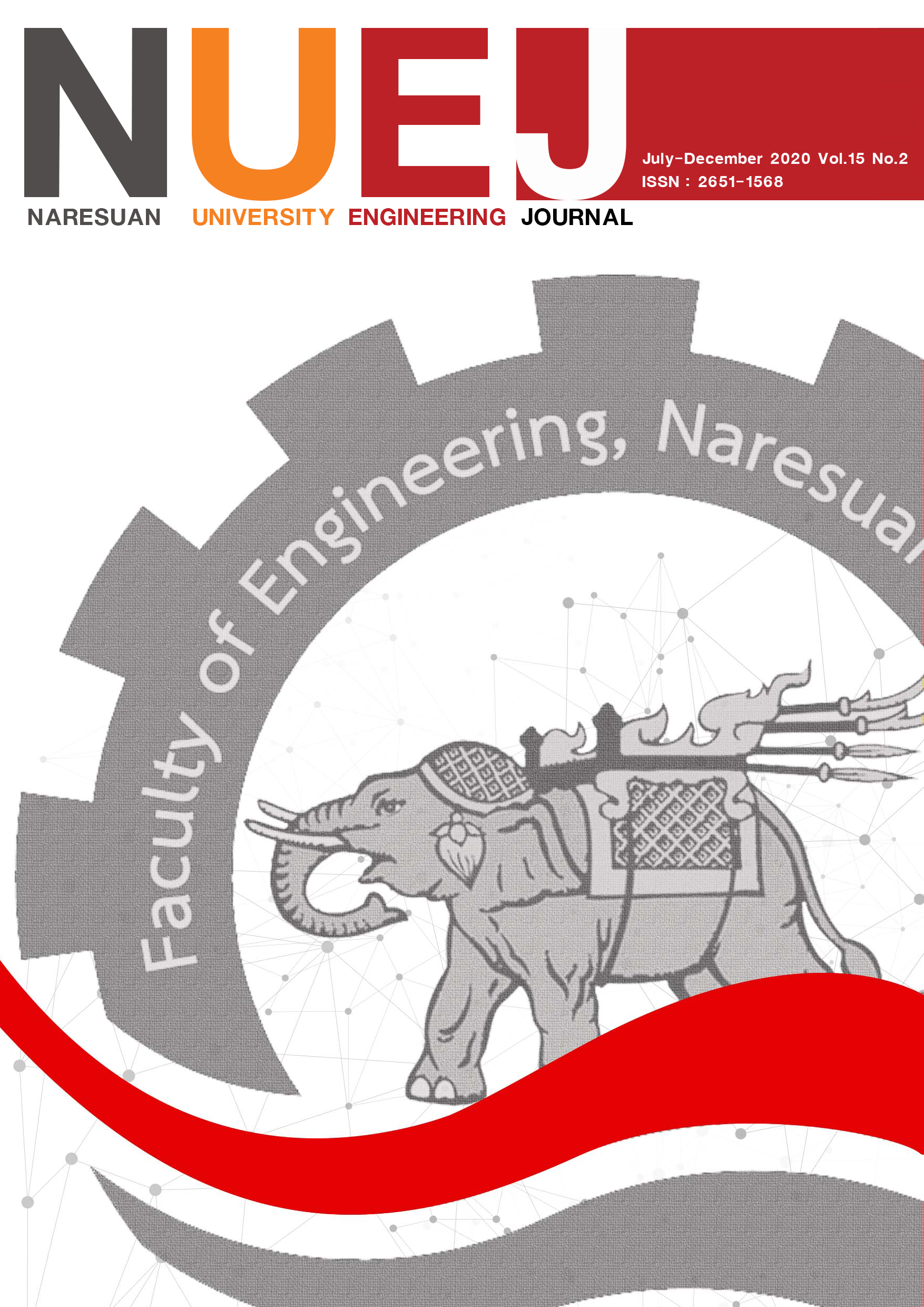Microstructure and Mechanical Properties of Friction Stir Welding of 2024 and 6061 Aluminium Semi-Solid Casting
Main Article Content
Abstract
The purpose of this research was studied friction stir welding of dissimilar butt joint materials between aluminum cast semi-solid 2024 and aluminum semi-solid 6061 with the sample dimensions of thickness of 4 mm, width 50 mm and length 100 mm. The analysis of the microstructure and mechanical properties under parameter the rotation speeds of 710, 1,000 and 1,400 rpm and the welding speeds of 40, 80 and 112 mm/min. It was found that the best friction stir welding condition in all experimental was used the rotation speed of 1,000 rpm, welding speed 112 mm/min the value of tensile strength and maximum hardness in the stirred area (Stir Zone: SZ) are 190.4 MPa and 137 HV respectively. Addition to, metallurgical the welding is characterized by wide welds when using a high welding speed and has a smooth welding surface when using a high welding speed.
Article Details
References
Ali, A., Brown, M. W., Rodopoulos, C. A., & Gardiner, S. (2006). Characterization of 2024-T351 friction stir welding joints. Journal of Failure Analysis and Prevention, 6, 83-96.
Amancio-Filho, S. T., Sheikhi, S., Dos Santos, J. F., & Bolfarini, C. (2008). Preliminary study on the microstructure and mechanical properties of dissimilar friction stir welds in aircraft aluminium alloys 2024-T351 and 6056-T4.
Journal of Materials Processing Technology, 206, 132-142.
Amancio-Filho, S.T., Sheikhi, S., Dos Santos, J.F., & Bolfarini, C. (2008). Preliminary study on the microstructure and mechanical properties of dissimilar friction stir welds in aircraft aluminium alloys 2024-T351 and 6056-T4. Journal of Materials Processing Technology, 206, 132-142.
Babu, S., Janaki Ram, G.D., Venkitakrishnan, P.V., Madhusudhan Reddy, G. & Prasad Rao, K. (2011).
Microstructure and Mechanical Properties of Friction Stir Lap Welded Aluminum Alloy AA2014. Journal of Materials Processing Technology, 28, 414-426.
Boonchouytan, W., Cheewawuttipong, W., & Burapa, R. (2017). Microstructural Behavior and Mechanical Properties of Friction Stir Spot Welding of Dissimilar Aluminum Semi Solid Casting Sheets SSM2024 and SSM6061. Srinakharinwirot Engineering Journal, 12(2), 130-142.
Booth, D. P. P., Starink, M. J., & Sinclair, I. (2007). Analysis of local microstructure and hardness of 13 mm gauge 2024-T351 AA friction stir welds. Materials Science and Technology, 23, 276-284.
Caroline, J., Bruno de, M., Anne, D. & Aude, S. (2013). Torque, temperature and hardening precipitation evolution in dissimilar friction stir welds between 6061-T6 and 2014-T6 aluminum alloys. Journal of Materials Processing Technology, 213, 826-837.
Chen, Z. W., & Cui, S. (2008). On the forming mechanism of banded structures in aluminium alloy friction stir welds. Scripta Materialia, 58, 417- 420.
Ericsson, M. & Sandström, R. (2003). Influence of welding speed on the fatigue of friction stir welds, and comparison with MIG and TIG. International Journal of Fatigue, 25, 1379-1387.
Golestaneh, A.F., Aidy, A., & Zadeh, M. (2009). Modeling the fatigue crack growth in friction stir welded joint of 2024-T351 Al alloy. Materials and Design, 30, 2928-2937.
Gonçalo, S., Hao, W., Pedro, V., & Telmo, G.S. (2017). FSW of aluminum AA5754 to steel DX54 with innovative overlap joint. Weld World, 61, 257-268.
Hasan, J., Hadi, M., & Mohammad, H. (2019). Investigation of residual stress distribution of dissimilar Al-7075-T6 and Al-6061-T6 in the friction stir welding process strengthened with SiO2 nanoparticles. Journal of Manufacturing Processes, 43, 145-153.
Heidarzadeh, A., Khodaverdizadeh, H., Mahmoudi, A., & Nazari, E. (2012). Tensile behavior of friction stir welded AA 6061-T4 aluminum alloy joints. Materials and Design, 37, 166-173.
Kanwer, S., Arora, S. P., Michael, S., & Rajneesh, K. (2010). Effect of process parameters on friction stir welding of aluminum alloy 2219-T87. International Journal of Advanced Manufacture Technology, 50, 941-952.
Krishnan, K. N. (2002). On the formation of onion rings in friction stir welds. Materials Science and Engineering A, 327, 246-251.
Lockwood, W.D., Tomaz, B. & Reynolds, A.P. (2002). Mechanical response of friction stir welded AA 2024: Experiment and modelling. Materials Science and Engineering A, 323, 348-353.
Sadeesh, P., Venkatesh, K.M., Rajkumar, V., Avinash, P., Arivazhagan, N., Devendranath, Ramkuma,r K. & Narayanan, S. (2014). Studies on friction stir welding of AA 2024 and AA 6061 dissimilar metals. Procedia Engineering, 75, 145-149.
Shen, Z., Chen, Y., Haghshenas, M., & Gerlich, A. P. (2015). Role of welding parameters on interfacial bonding in dissimilar steel/aluminum friction stir welds. Engineering Science and Technology, an International Journal, 18, 270-277.
Shusheng, D., Xinqi, Y., Guohong, L., & Bo, J. (2006). Comparative study on fatigue properties between AA2024-T4 friction stir welds and base materials. Materials Science and Engineering A, 435-436, 389-395.
Ying, L., Murr, L.E., & Mc Clure, J.C. (1999). Flow visualization and residual microstructures associated with the friction-stir welding of 2024 aluminum to 6061 aluminum. Materials Science and Engineering: A, 271, 213-223.
Zhang, Z., Xiao, B. L., & Ma, Z. Y. (2012). Effect of welding parameters on microstructure and mechanical properties of friction stir welded 2219Al-T6 joints. Journal of Materials Science, 47, 4075-4086.


